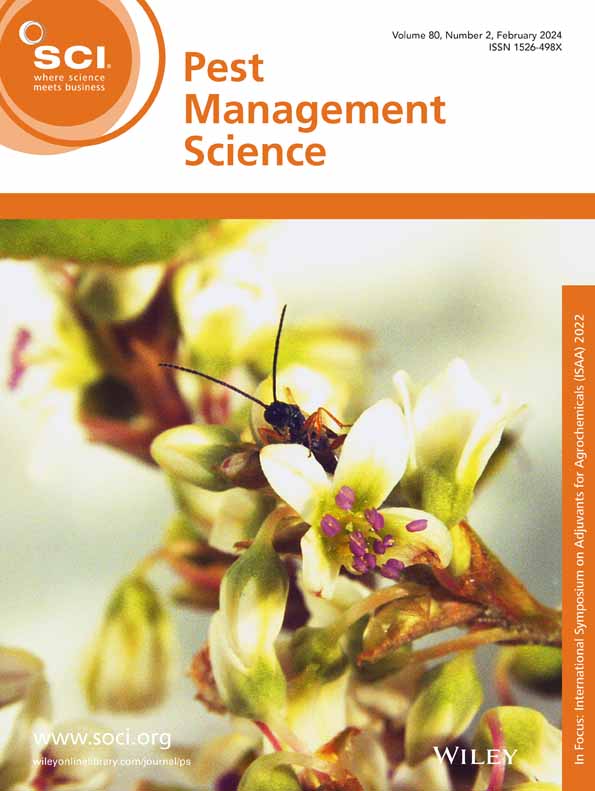利用氢稳定同位素分析入侵松材线虫病媒昆虫的溯源性
IF 3.8
1区 农林科学
Q1 AGRONOMY
引用次数: 0
摘要
松树枯萎病病原菌bursaphelenchus xylophilus在全球范围内对松林造成严重威胁,其侵染速度快,可在40天内导致树木死亡。该疾病通过病媒甲虫有效传播,其中交替毛仓鼠和沙仓鼠是主要病媒,加色毛仓鼠被认为是中国潜在的病媒。分子溯源和稳定同位素溯源都是昆虫溯源的重要技术,各有其优势和局限性。分子可追溯性,如基于DNA的方法,在鉴定昆虫物种方面提供了高特异性和准确性,但由于需要先进的设备和熟练的人员,它可能需要更复杂的程序和更高的成本。然而,稳定同位素示踪提供了保守和高精度的特征,并且是无标签的,使其适用于在复杂环境中追踪昆虫的起源和途径。采用脱脂的方法,去除样品表皮的脂肪,只留下骨骼部分,并清空腹腔,防止食物影响氢同位素的测定。本研究旨在利用氢稳定同位素比值追踪这些病媒昆虫在中国的地理起源,为疾病管理提供新的工具。结果采用R和Origin软件对数据进行处理和建模,得到方程y = 0.9822x + 19.1765。统计检验证实了模型的显著性和拟合性。结果表明,温度和降水与大气氢同位素组成呈显著正相关。结论该模型可用于跟踪松材枯萎病媒介的传播,为松材枯萎病的防治提供了一种新的思路。如果将样品同位素测试值带入模型并在划分图中标注,则可以证明该模型能够有效识别样品的源信息。©2025化学工业协会。本文章由计算机程序翻译,如有差异,请以英文原文为准。
Employing hydrogen stable isotope analysis for traceability of invasive pine wood nematode vector insects
BACKGROUNDBursaphelenchus xylophilus , the pathogen responsible for pine wilt disease, significantly threatens pine forests globally, with rapid infection leading to tree mortality within 40 days. This disease spreads efficiently through vector beetles, with Monochamus alternatus and Monochamus saltuarius serving as the primary vectors and Monochamus galloprovincialis being considered a potential vector in China. Molecular traceability and stable isotope traceability are both important techniques for insect tracing, each with its own advantages and limitations. Molecular traceability, such as DNA‐based methods, offers high specificity and accuracy in identifying insect species, but it may require more complex procedures and higher costs due to the need for advanced equipment and skilled personnel. Stable isotope tracing, however, provides conservative and high‐precision signatures, and is label‐free, making it suitable for tracing the origins and pathways of insects in complex environments. Using the method of degreasing, the fat of the sample epidermis was removed, only the bone part was left, and the abdominal cavity was emptied to prevent the food from affecting the determination of hydrogen isotope. The present study aimed to trace the geographic origins of these vector insects in China using hydrogen stable isotope ratios, providing a novel tool for disease management.RESULTSData processing and modeling were conducted using R and Origin software, yielding the equation y = 0.9822x + 19.1765. Statistical tests confirmed the model's significance and fit. Results indicate a significant positive correlation of temperature and precipitation with atmospheric hydrogen isotopic composition.CONCLUSIONOur findings demonstrate the model's applicability in tracking the spread of pine wilt vectors, offering a promising approach to forest pathogen management. If the sample isotope test value is brought into the model and marked in the partition diagram, it can be proved that the model can effectively identify the source information of the sample. © 2025 Society of Chemical Industry.
求助全文
通过发布文献求助,成功后即可免费获取论文全文。
去求助
来源期刊

Pest Management Science
农林科学-昆虫学
CiteScore
7.90
自引率
9.80%
发文量
553
审稿时长
4.8 months
期刊介绍:
Pest Management Science is the international journal of research and development in crop protection and pest control. Since its launch in 1970, the journal has become the premier forum for papers on the discovery, application, and impact on the environment of products and strategies designed for pest management.
Published for SCI by John Wiley & Sons Ltd.
 求助内容:
求助内容: 应助结果提醒方式:
应助结果提醒方式:


